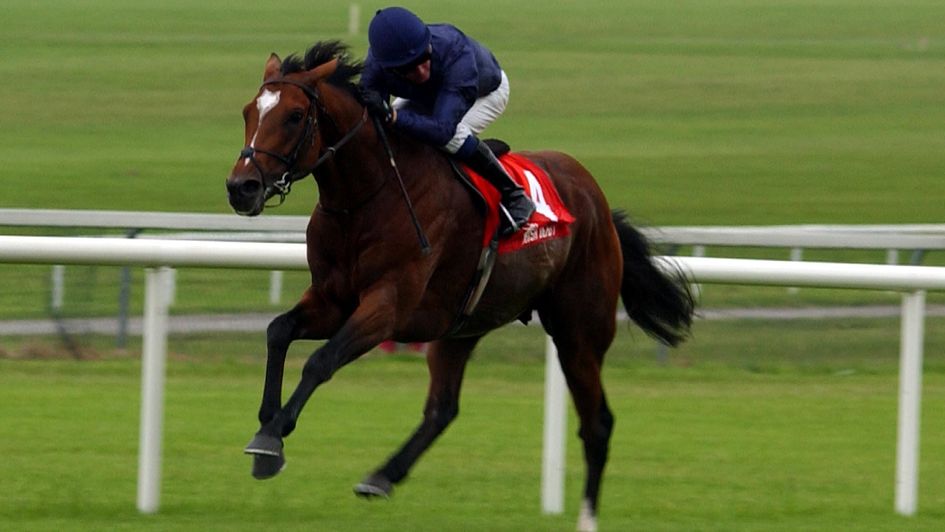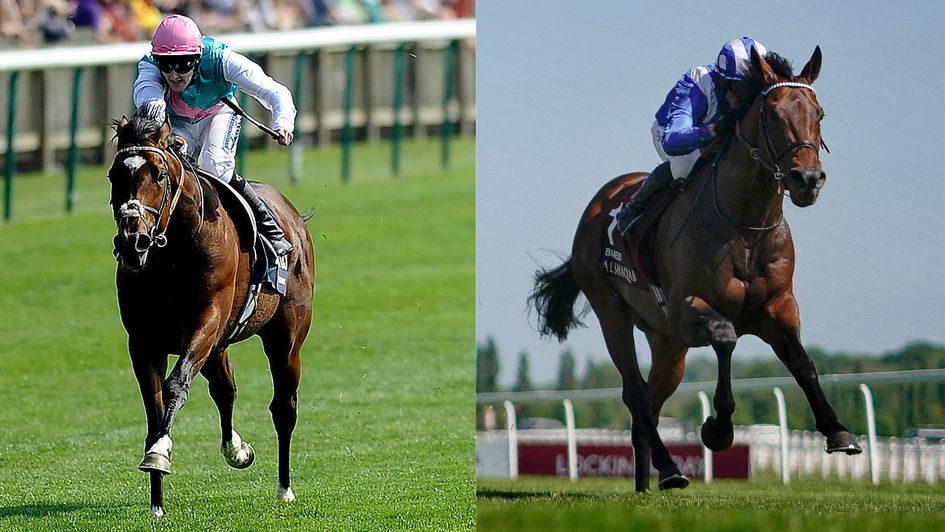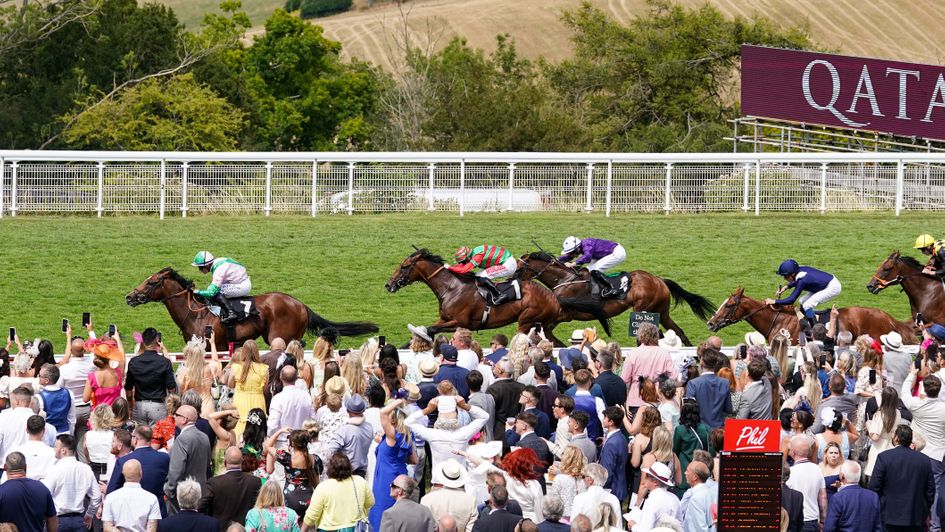
Urban Sea, Hasili and Fall Aspen: Three of racing's great families
John Ingles highlights the exploits of three of the most influential broodmares of recent times.
Urban Sea
Look back on the field for the 2019 Derby for some idea of Urban Sea’s influence. Thanks to her son Galileo, who was either the sire, grandsire or great grandsire of 12 of the 13 runners, Urban Sea’s name appeared in the top half of the pedigrees of all bar one of the field. The exception was the beaten favourite Sir Dragonet in fifth, though he was a direct descendant of Urban Sea through his dam Sparrow, Urban Sea’s granddaughter.
Urban Sea’s close connection with the Derby began when Galileo won the race in 2001, while Sea The Stars’ victory eight years later meant that Urban Sea became only the 12th mare in the long history of the race, and just the second since the start of the 20th century, to produce two Derby winners. Not only that, both Galileo and Sea The Stars have themselves sired other Derby winners. Galileo is the most successful stallion in the race’s history - Serpentine in 2020 was his fifth son to be successful - Sea The Stars was responsible for the 2016 winner Harzand.
Trained in France by Jean Lesbordes, Urban Sea was a high-class mare, though her rating of 126 meant that she wasn’t up to the usual extremely high standards of a Prix de l’Arc de Triomphe winner. Never having previously won above Group 3 level, or over a mile and a half, the four-year-old Urban Sea pulled off a shock win in the 1993 Arc at odds of 37/1 in a close finish with the British-trained pair White Muzzle and Opera House.
The Arc was the final race in the brilliant three-year-old season of Sea The Stars who had also won the 2000 Guineas prior to the Derby and then remained unbeaten that year with wins in the Eclipse, the Juddmonte International and the Irish Champion Stakes before he emulated his dam at Longchamp. Rated 140, Sea The Stars is the best Flat horse to have been trained in Ireland since the Second World War, while at stud his best winners have included Baaeed, Crystal Ocean and Stradivarius.
Galileo added to his Derby victory by winning the Irish Derby and King George at Ascot, proving himself a top-class colt in the process and earning a rating of 134. Sea The Stars might have been the better racehorse, but Galileo, who sadly died in 2021, proved in a class of his own as a stallion, surpassing even his own sire Sadler’s Wells’ achievements at stud and becoming champion sire in Britain and Ireland for the 12th time in 2020.
Producing a stallion as good as Galileo and a racehorse as good as Sea The Stars rank as Urban Sea’s greatest claims to fame, though she produced other good horses, including two other Group/Grade 1 winners. Galileo’s brother Black Sam Bellamy (rated 121) won the Tattersalls Gold Cup and Gran Premio del Jockey Club before initially standing at stud in Germany (where Urban Sea’s family originated). However, he later become a jumps stallion, producing the likes of Cheltenham Gold Cup runner-up The Giant Bolster and very smart staying hurdler Sam Spinner.
Urban Sea’s other top-level winner was the filly My Typhoon, an American-trained daughter of Giant’s Causeway, who won the Diana Stakes at Saratoga. Not surprisingly, few from this family come up for public auction and those who do are bound to fetch big money. That was the case with My Typhoon who had been sold for a then record 1.8m guineas at Tattersalls as a foal.
Urban Sea’s first and final foals, Urban Ocean (114) and Born To Sea (117), were both smart colts, Urban Ocean winning the Group 3 Gallinule Stakes and Born To Sea finishing second in the Irish Derby. Sadly, Urban Sea died suddenly in 2009 from complications after giving birth to Born To Sea.
But it’s not just Urban Sea’s sons who have made their mark at stud. Galileo’s sister All Too Beautiful (113) was runner-up to Ouija Board in the Oaks and her own daughter Wonder of Wonders was also second at Epsom after winning the Cheshire Oaks.
Another of Urban Sea’s daughters Cherry Hinton (103), who was fifth in the Oaks, remained a maiden despite showing useful form. At stud she has produced the smart Ballydoyle fillies Goddess, Athena, Bracelet and Wading. Bracelet won the Ribblesdale Stakes and Irish Oaks, while Wading, along with her own daughter Just Wonderful, won the Rockfel Stakes.
Much of Urban Sea’s success as a broodmare has been shared between either the Tsui family, in whose colours she raced, or Coolmore. But Godolphin managed to secure her first filly, later named Melikah, for ten million francs (another record at the time) as a yearling at Deauville. Melikah was the result of a mating between two Arc winners as her sire was Lammtarra. She won the listed Pretty Polly Stakes at Newmarket on her debut before finishing third in the Oaks and second in the Irish Oaks and went on to found a successful branch of the Urban Sea family for the Maktoums.
Melikah’s own foals include the Arc third Masterstroke and 2019 September Stakes winner Royal Line, but, more importantly, her great grandson Masar became the first colt to carry the Godolphin colours to victory in the Derby in 2018, thereby writing another chapter in Urban Sea’s association with the great race.
Hasili
There is no magic formula for breeding champions but a mating that had repeated success at a high level was the one between Danehill and the Juddmonte broodmare Hasili. It resulted in five foals, all of whom reached a very smart or high-class level of form, four of them becoming Group/Grade 1 winners.
Overall, Hasili produced six winners who achieved Timeform ratings in the 120-128 range, something which not even some stallions manage from many more opportunities, and her total of five top-level winners constitutes a record in the northern hemisphere (You’resothrilling could equal the record if Toy wins the German Oaks this weekend). Among Hasili's foals are three brothers who have all themselves sired Group 1 winners.
Hasili was by the Derby winner Kahyasi but there was speed on her dam’s side as her grandam Sookera won the Cheveley Park Stakes, even though she too was by a Derby winner, Roberto. Trained by Alex Pantall, Hasili won four times in the French Provinces at two, including a debut success over five furlongs and a listed win at Nantes over an extended mile. Hasili’s three-year-old season began promisingly with a second in the Prix Imprudence at Maisons-Laffitte but she failed to add to her two-year-old successes and her racing career ended rather tamely with a defeat in blinkers back in the Provinces.
But Hasili was an immediate success at stud with her first mating with Danehill resulting in the high-class miler Dansili (rated 127). While his most important win came in the Group 2 Prix du Muguet as a four-year-old, as his rating suggests, he was very much up to Group 1 standard and was placed several times at that level, including in the Poule d’Essai des Poulains, the Sussex Stakes (when beaten by Giant’s Causeway) and the Breeders’ Cup Mile. In fact, he suffered an unlucky defeat at Churchill Downs when beaten only a neck and a nose after not getting a clear run.
The lack of a Group 1 on his CV mattered little to Dansili’s stallion career as his success propelled his stud fee from £8,000 when he started out to a peak of £100,000. His best offspring included the runaway King George VI & Queen Elizabeth Stakes winner Harbinger, the Arc winner Rail Link and Flintshire, runner-up twice in both the Arc and Breeders’ Cup Turf. Dansili sadly died last year but his son Bated Breath still stands at Juddmonte's Banstead Manor.
Dansili was trained by Andre Fabre, as were all of Hasili’s foals, though several of them were transferred later in their careers to Bobby Frankel in America. Hasili’s next foal was her first filly Banks Hill (128) who achieved the highest rating of any of her offspring. She enjoyed better luck than her brother at the Breeders’ Cup, winning the Filly & Mare Turf at three, having won the Coronation Stakes at Royal Ascot that season, and went on to win the Prix Jacques le Marois as a four-year-old.
Hasili’s third foal Heat Haze (120) was the odd one out among her best horses in being by Green Desert rather than Danehill, but she maintained the standards set by her elder siblings by winning a pair of Grade 1 contests for Frankel at four, the Beverly D Stakes at Arlington and the Matriarch Stakes at Hollywood.
Returning to Danehill, fourth foal Intercontinental (122) proved well named as she too enjoyed success in both Europe and America. Having finished third in the 1000 Guineas for Fabre, she followed in her siblings’ footsteps by winning the Matriarch at four and then the Breeders’ Cup Filly & Mare Turf at five in which she made all to beat the previous year’s winner Ouija Board.
Hasili’s last two foals by Danehill, the colts Cacique and Champs Elysees (both 124), were two more who won their biggest races across the Atlantic. Cacique’s Grade 1 wins came in the Man O’War Stakes and Manhattan Handicap, while Champs Elysees won the Canadian International, the Northern Dancer Turf Stakes and the Hollywood Turf Cup. All of Champs Elysees’ Grade 1 wins came at a mile and a half and he showed the most stamina out of Hasili’s foals.
While he sired the 1000 Guineas winner Billesdon Brook, Champs Elysees has largely been an influence for stamina, too, at stud, with Gold Cup winner Trip To Paris among his best horses. Cacique’s stud career was troubled by fertility problems, but he nonetheless sired Prix Jean Prat winner Mutual Trust and the Hong Kong Vase winner Dominant.
It was down to his siblings’ exploits on the track, rather than his own racing career (he ran just once) that Hasili’s Sadler’s Wells foal Raise The Flag found a place at stud in New Zealand. He was Hasili’s only runner not to win a race. Hasili’s final runner and winner was Deluxe (113), a daughter of Storm Cat, a listed winner at Longchamp who finished second in the Prix Saint-Alary in her bid to become her dam’s sixth Group/Grade 1 winner.
Hasili produced ten foals in all before she was retired from broodmare duties in 2012, and she died in March 2018.
Fall Aspen
Although an American dirt performer herself, Fall Aspen’s influence as a broodmare over the last 40 years has extended worldwide to include top performers on turf as well as dirt, and includes a number of big-race winners in Britain. She was given the best opportunities to succeed at stud, visiting such stallions as Northern Dancer, Sadler’s Wells and Danzig during her broodmare career and, once she began to make a name for herself, her foals attracted some of the biggest names in bloodstock, including Sheikh Mohammed, Sheikh Hamdan and the Coolmore partners who each had winning offspring of hers in their colours. Fall Aspen changed hands several times, and Coolmore’s John Magnier was her final buyer, paying $2.4m for her when she was an 18-year-old in 1994, in foal to Danzig.
Fall Aspen won eight of her 20 starts, with her biggest win coming as a two-year-old in the Grade 1 Matron Stakes at Belmont. Timeform did not produce American ratings at the time, though the Experimental Free Handicap, America’s official two-year-old rankings, rated her just 4 lb behind the joint-top two-year-old fillies.
At stud, Fall Aspen went on to produce 14 foals, and 12 winners from the 13 who raced. There was no single foal which stood out from the rest, but only because the main feature of her broodmare record was the consistently high quality of the horses she produced. No fewer than nine of her foals achieved a Timeform rating between 117 and 125. They included four Group/Grade 1 winners and another four who won at Group 2 or Group 3 level.
Besides her offspring’s class, the other striking feature of Fall Aspen’s broodmare record is the variety of the foals she produced, not just both turf and dirt performers, but also everything from sprinters to a stayer. Mated with speed influence Danzig, she got the July Cup winner Hamas (who was her highest-rated foal on 125) and his brother the Diadem Stakes winner Bianconi (123), the foal she was carrying when John Magnier bought her. But sent to stamina influence Alleged, Fall Aspen produced the Goodwood Cup winner Mazzacano (117), successful when the race was still run over 21 furlongs.
Across the Atlantic, Fall Aspen’s best foal on dirt was Timber Country (124), named champion two-year-old colt in North America in 1994 when he won the Breeders’ Cup Juvenile. He also won the Preakness Stakes the following year after finishing third in the Kentucky Derby. A year after Timber Country, another of Fall Aspen’s sons Prince of Thieves (119) also finished third in the Kentucky Derby.
Fall Aspen’s very first foal, the Northern Dancer filly Northern Aspen (rated 120 as a three-year-old in France) got her dam’s stud career off to a flying start by winning the Grade 1 Gamely Handicap at Hollywood as a four-year-old when trained by John Gosden, then based in California. Fall Aspen’s other top-level winner was Sheikh Mohammed’s Grand Prix de Paris winner Fort Wood (117) who later enjoyed a very successful stallion career in South Africa.
But it has been Fall Aspen’s daughters rather than her sons who have done most to carry her legacy into the 21st century. Chief among them are Colorado Dancer and Elle Seule (both rated 122) who each gained their biggest successes in Group 2 contests at Deauville, Colorado Dancer winning the Prix de Pomone and Elle Seule emulating her half-sister Northern Aspen by winning the Prix d’Astarte (nowadays the Prix Rothschild).
Colorado Dancer earned fame in her own right as the dam of Dubai Millennium, the outstanding Dubai World Cup winner and the best horse to carry the Godolphin colours. Dubai Millennium’s stallion career was tragically short but he did leave behind Godolphin’s flagship sire Dubawi.
Elle Seule was responsible for the family’s second July Cup winner Elnadim (he also won the Diadem Stakes, like Bianconi) and Mehthaaf, winner of the Irish 1000 Guineas. Mehthaaf has since become the great grandam of Ribchester who enjoyed a top-class miling career in the Godolphin colours for Richard Fahey.
Occupandiste, a granddaughter of Elle Seule and a dual Group 1 winner in France, is another mare from the family to have excelled both on the track and at stud. The winner of the Prix Maurice de Gheest and Prix de la Foret, Occupandiste produced Mondialiste, winner of the Arlington Million for David O’Meara, and she is also the grandam of the Prix du Jockey Club winner Intello.
The Racing Post Trophy winner Medaaly and his half-brother Charnwood Forest, a high-class miler, were out of another of Fall Aspen’s daughters, the unraced Dance of Leaves, while Richmond Stakes winner Harbour Watch - the sire of King George winner Pyledriver - is the grandson of yet another of Fall Aspen’s daughters Sheroog.
More from Sporting Life
Safer gambling
We are committed in our support of safer gambling. Recommended bets are advised to over-18s and we strongly encourage readers to wager only what they can afford to lose.
If you are concerned about your gambling, please call the National Gambling Helpline / GamCare on 0808 8020 133.
Further support and information can be found at begambleaware.org and gamblingtherapy.org.
Next Off
Most Followed
MOST READ RACING






















